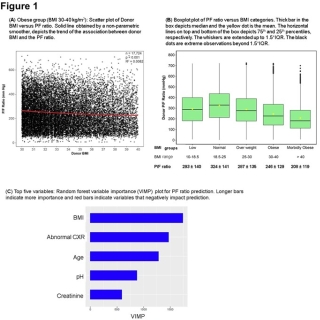High Body Mass Index in Organ Donor is Significantly Correlated to Low PaO2/FiO2 Ratio in SRTR Database
T. Okamoto,1 L. Thuita,1 H. Niikawa,1 K. Ayyat,1 Y. Itoda,1 M. Valpour,2 E. Blackstone,1 K. McCurry.1
1Thoracic and Cardiovascular Surgery, Cleveland Clinic, Cleveland
2Respiratory Medicine, Cleveland Clinic, Cleveland.
Meeting: 2018 American Transplant Congress
Abstract number: C256
Keywords: Donors, Lung transplantation, unrelated
Session Information
Session Name: Poster Session C: Lung: All Topics
Session Type: Poster Session
Date: Monday, June 4, 2018
Session Time: 6:00pm-7:00pm
 Presentation Time: 6:00pm-7:00pm
Presentation Time: 6:00pm-7:00pm
Location: Hall 4EF
Background:
Atelectasis is a major cause of hypoxemia in organ donors. However, the risk factors of hypoxemia unknown. Our previous study suggested that donors with high body mass index (BMI) tend to have larger atelectasis, resulting in poorer oxygenation and non-utilization of lungs. Generally, it is postulated that mechanical compression of the chest leads to atelectasis under general anesthesia. Moreover, ex vivo lung perfusion (EVLP) might improve the lung function of donor lungs with atelectasis. Therefore, the identification of specific donor population of large atelectasis is important to expand donor lung pool. Our hypothesis is that donors with elevated BMI result in lower P/F ratio and lower lung utilization rate, compared with donors with normal BMI. The aim of this study was to investigate the significance of donor BMI to oxygenation level and lung utilization rate.
Methods:
From Jan 2006 to Jun 2015, the data of all donors (heart, lung, liver, kidney, intestine and pancreas) were obtained from UNetsm. All donors (n = 75,408) were divided into the following 5 BMI groups: Low (10-18.5), Normal (18.5-25), Over weight (25-30), Obese (30-40) and Morbidly Obese (> 40). Donor PaO2/FiO2 (P/F) ratio and lung utilization were analyzed according to BMI groups.
Results:
The donor age was 40.3 ± 18. There was a significant correlation between donor P/F ratio and BMI in all groups (p < 0.0001). As a representative, the correlation in Obese group is shown (n = 17,724, R2 = 0.0082, p < 0.0001) [Figure 1]. The mean P/F ratio was dependent on donor BMI groups [Figure 1]. In non-parametric Random Forest analysis, donor BMI was the most important predictor of donor P/F ratio [Figure 1]. P/F ratio was the most important predictor of lung utilization, compared with donor BMI. Conclusion:
Conclusion:
These data might result in better understanding of appropriate donor candidates of standard donors as well as marginal donors, which will be recovered by EVLP. Therefore, new findings lead to significant increase of donor lung supply.
CITATION INFORMATION: Okamoto T., Thuita L., Niikawa H., Ayyat K., Itoda Y., Valpour M., Blackstone E., McCurry K. High Body Mass Index in Organ Donor is Significantly Correlated to Low PaO2/FiO2 Ratio in SRTR Database Am J Transplant. 2017;17 (suppl 3).
To cite this abstract in AMA style:
Okamoto T, Thuita L, Niikawa H, Ayyat K, Itoda Y, Valpour M, Blackstone E, McCurry K. High Body Mass Index in Organ Donor is Significantly Correlated to Low PaO2/FiO2 Ratio in SRTR Database [abstract]. https://atcmeetingabstracts.com/abstract/high-body-mass-index-in-organ-donor-is-significantly-correlated-to-low-pao2-fio2-ratio-in-srtr-database/. Accessed December 7, 2025.« Back to 2018 American Transplant Congress
